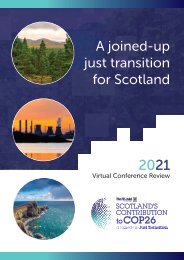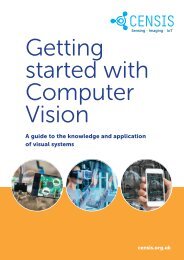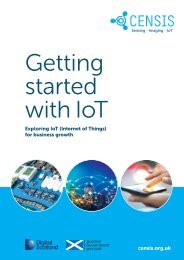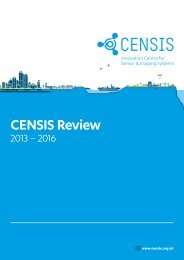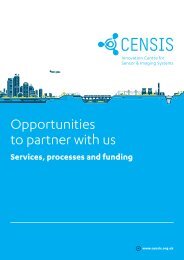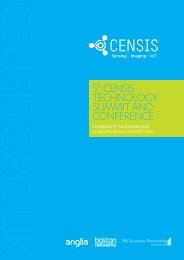CENSIS white paper: Intellectual Property in Business
2023: This CENSIS white paper sets out to make the topic of IP more approachable, less intimidating and more manageable, offering experience-based advice and methods are are designed to help businesses structure their IP- related issues and makes the best of their IP. Covering: The role of IP, IP management during growth, IP strategy for expanding companies and corporates, Business IP Canvas - merging IP with your business model.
2023: This CENSIS white paper sets out to make the topic of IP more approachable, less intimidating and more manageable, offering experience-based advice and methods are are designed to help businesses structure their IP- related issues and makes the best of their IP.
Covering:
The role of IP, IP management during growth, IP strategy for expanding companies and corporates, Business IP Canvas - merging IP with your business model.
Create successful ePaper yourself
Turn your PDF publications into a flip-book with our unique Google optimized e-Paper software.
<strong>Intellectual</strong> <strong>Property</strong> <strong>in</strong> Bus<strong>in</strong>ess: IP basics, IP management, IP strategy<br />
IP Basics for Start-ups (cont<strong>in</strong>ued)<br />
4 IP ownership - Keep records<br />
of where ideas come from<br />
Allocation of IP ownership is a critical issue for every<br />
bus<strong>in</strong>ess (regardless of its maturity). Investors and<br />
buyers will always require ownership <strong>in</strong>formation –<br />
after all, they will pay only for assets that belong to<br />
the bus<strong>in</strong>ess.<br />
Employment contracts<br />
Certa<strong>in</strong> rules regard<strong>in</strong>g ownership are set out <strong>in</strong> law.<br />
For example, <strong>in</strong> the UK, IP developed by an employee<br />
<strong>in</strong> the course of employment will usually belong to the<br />
employer. Although this is the typical legal position, it is<br />
advisable for the sake of clarity and certa<strong>in</strong>ty to <strong>in</strong>clude<br />
an explicit clause <strong>in</strong> the employment contract (or <strong>in</strong> a<br />
separate agreement dur<strong>in</strong>g the onboard<strong>in</strong>g procedure).<br />
And s<strong>in</strong>ce directors are not necessarily considered as<br />
employees, it is also advisable to use directors’ service<br />
contracts and to <strong>in</strong>clude IP clauses <strong>in</strong> them. 11<br />
In terms of ownership, companies should also pay<br />
attention to:<br />
1 IP registration processes, e.g., <strong>in</strong> the US, patents must<br />
be assigned to a company. A company is not named<br />
as a patent owner <strong>in</strong> the document, only <strong>in</strong> the<br />
digital files visible <strong>in</strong> the USPTO system.<br />
2 IP acquisition from third parties such as web design,<br />
content design and brand<strong>in</strong>g suppliers. Copyright<br />
ownership could otherwise rema<strong>in</strong> with the content<br />
creators after delivery, thereby potentially restrict<strong>in</strong>g<br />
future use.<br />
3 Purchases made by <strong>in</strong>dividual employees, e.g.,<br />
doma<strong>in</strong> names. In such cases, a company should<br />
ensure transfer of ownership.<br />
4 Jo<strong>in</strong>t developments with other organisations<br />
(e.g., development documentation, IP ownership,<br />
exploitation rights). A company should be clear<br />
about its <strong>in</strong>tentions and <strong>in</strong>terests when jo<strong>in</strong><strong>in</strong>g such<br />
projects, negotiate accord<strong>in</strong>gly and capture agreed<br />
terms <strong>in</strong> a collaboration and exploitation agreement.<br />
Once the project starts, it should document its own<br />
developments, e.g., track<strong>in</strong>g the work of employees<br />
<strong>in</strong>volved <strong>in</strong> the project.<br />
Background IP<br />
In the R&D context, background IP is pre-exist<strong>in</strong>g<br />
IP brought <strong>in</strong>to a project by a collaborat<strong>in</strong>g party.<br />
At the end of the project, if the background IP has<br />
been <strong>in</strong>corporated <strong>in</strong>to new developments<br />
(the foreground IP) or is otherwise required to work<br />
the foreground results commercially, the party wish<strong>in</strong>g<br />
to exploit the foreground must ensure it also has the<br />
rights to the relevant background IP. This can be done<br />
through an assignation or a licence, whichever is<br />
agreeable to those <strong>in</strong>volved and legally possible.<br />
The position is very similar <strong>in</strong> a start-up context. When<br />
part of the IP has been developed prior to the company<br />
be<strong>in</strong>g established – a common scenario for sp<strong>in</strong>outs<br />
from academia, research facilities or corporations – the<br />
funders should ensure that the relevant IP is licensed<br />
(preferably exclusively) or assigned (if possible) to the<br />
start-up <strong>in</strong> a written agreement.<br />
Start-up idea vs ‘day job’<br />
The situation can easily become complicated when<br />
company founders work on a new solution for a start-up<br />
when concurrently employed <strong>in</strong> a different organisation.<br />
In such situations, it is critical to draw a clear l<strong>in</strong>e<br />
between the time and efforts <strong>in</strong>vested <strong>in</strong> the start-up<br />
technology and the work done <strong>in</strong> the ‘day job, carefully<br />
record<strong>in</strong>g the start-up work that has been done, the<br />
resources used and where the work was done.<br />
Even with this recorded, those clear l<strong>in</strong>es may still<br />
become blurred if the start-up technology and the<br />
day job happen to be <strong>in</strong> the same field of technology/<br />
bus<strong>in</strong>ess 12 . As expla<strong>in</strong>ed, <strong>in</strong> most cases employees will<br />
be required, as part of their contract of employment, to<br />
sign an IP assignment clause (or a separate agreement);<br />
<strong>in</strong> do<strong>in</strong>g so, they assign to the employer ownership of<br />
ideas and solutions related to their role <strong>in</strong> the bus<strong>in</strong>ess.<br />
This could also apply to ideas developed outside the<br />
day job where the employee is us<strong>in</strong>g the same skills and<br />
know-how that their job requires of them. Furthermore,<br />
employment contracts often <strong>in</strong>clude a non-competition<br />
obligation – add<strong>in</strong>g fuel to the fire if a start-up idea<br />
overlaps with the day job.<br />
Take-home message: Make sure that your employment<br />
contract <strong>in</strong>cludes both confidentiality provisions and IP<br />
assignment clauses. As a practical tip, it should become<br />
second nature to def<strong>in</strong>e transfer of ownership or<br />
licens<strong>in</strong>g of IP rights solely <strong>in</strong> a written form.<br />
11<br />
There is an exception <strong>in</strong> the higher education sector, where academics reta<strong>in</strong> rights <strong>in</strong> their academic works, even if they are created as part of<br />
their employment. ‘Gett<strong>in</strong>g your IP <strong>in</strong> order: stay <strong>in</strong> control of ownership’ (P<strong>in</strong>sent Manson, 2 November 2020) accessed 2 December 2022.<br />
12<br />
Harroch (n1).<br />
15






